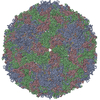+ Open data
Open data
- Basic information
Basic information
| Entry | Database: PDB / ID: 6i2k | |||||||||
|---|---|---|---|---|---|---|---|---|---|---|
| Title | Structure of EV71 complexed with its receptor SCARB2 | |||||||||
 Components Components |
| |||||||||
 Keywords Keywords | VIRUS / Enterovirus 71 / SCARB2 / Hand-foot-mouth disease / EV71 receptor | |||||||||
| Function / homology |  Function and homology information Function and homology informationregulation of glucosylceramide catabolic process / regulation of carbohydrate catabolic process / regulation of endosome organization / aminophospholipid transport / endosome to plasma membrane protein transport / regulation of lysosome organization / protein targeting to lysosome / phosphatidylcholine binding / cargo receptor activity / scavenger receptor activity ...regulation of glucosylceramide catabolic process / regulation of carbohydrate catabolic process / regulation of endosome organization / aminophospholipid transport / endosome to plasma membrane protein transport / regulation of lysosome organization / protein targeting to lysosome / phosphatidylcholine binding / cargo receptor activity / scavenger receptor activity / cholesterol binding / phosphatidylserine binding / symbiont-mediated suppression of host cytoplasmic pattern recognition receptor signaling pathway via inhibition of RIG-I activity / symbiont-mediated suppression of host cytoplasmic pattern recognition receptor signaling pathway via inhibition of MDA-5 activity / symbiont-mediated suppression of host cytoplasmic pattern recognition receptor signaling pathway via inhibition of MAVS activity / lysosomal lumen / receptor-mediated endocytosis / ribonucleoside triphosphate phosphatase activity / picornain 2A / symbiont-mediated suppression of host mRNA export from nucleus / symbiont genome entry into host cell via pore formation in plasma membrane / picornain 3C / clathrin-coated endocytic vesicle membrane / sensory perception of sound / T=pseudo3 icosahedral viral capsid / positive regulation of neuron projection development / host cell cytoplasmic vesicle membrane / endocytic vesicle membrane / late endosome membrane / viral capsid / transmembrane signaling receptor activity / Cargo recognition for clathrin-mediated endocytosis / nucleoside-triphosphate phosphatase / Clathrin-mediated endocytosis / protein-folding chaperone binding / channel activity / virus receptor activity / monoatomic ion transmembrane transport / clathrin-dependent endocytosis of virus by host cell / host cell cytoplasm / entry receptor-mediated virion attachment to host cell / DNA replication / RNA helicase activity / endosome membrane / symbiont-mediated suppression of host gene expression / Golgi membrane / symbiont-mediated activation of host autophagy / lysosomal membrane / RNA-directed RNA polymerase / cysteine-type endopeptidase activity / viral RNA genome replication / focal adhesion / RNA-directed RNA polymerase activity / DNA-templated transcription / endoplasmic reticulum membrane / virion attachment to host cell / host cell nucleus / structural molecule activity / enzyme binding / protein homodimerization activity / proteolysis / RNA binding / extracellular exosome / zinc ion binding / ATP binding / membrane / plasma membrane Similarity search - Function | |||||||||
| Biological species |  Homo sapiens (human) Homo sapiens (human)  Enterovirus A71 Enterovirus A71 | |||||||||
| Method | ELECTRON MICROSCOPY / single particle reconstruction / cryo EM / Resolution: 3.4 Å | |||||||||
 Authors Authors | Zhou, D. / Zhao, Y. / Kotecha, A. / Fry, E.E. / Kelly, J. / Wang, X. / Rao, Z. / Rowlands, D.J. / Ren, J. / Stuart, D.I. | |||||||||
| Funding support |  United Kingdom, 1items United Kingdom, 1items
| |||||||||
 Citation Citation |  Journal: Nat Microbiol / Year: 2019 Journal: Nat Microbiol / Year: 2019Title: Unexpected mode of engagement between enterovirus 71 and its receptor SCARB2. Authors: Daming Zhou / Yuguang Zhao / Abhay Kotecha / Elizabeth E Fry / James T Kelly / Xiangxi Wang / Zihe Rao / David J Rowlands / Jingshan Ren / David I Stuart /    Abstract: Enterovirus 71 (EV71) is a common cause of hand, foot and mouth disease-a disease endemic especially in the Asia-Pacific region. Scavenger receptor class B member 2 (SCARB2) is the major receptor of ...Enterovirus 71 (EV71) is a common cause of hand, foot and mouth disease-a disease endemic especially in the Asia-Pacific region. Scavenger receptor class B member 2 (SCARB2) is the major receptor of EV71, as well as several other enteroviruses responsible for hand, foot and mouth disease, and plays a key role in cell entry. The isolated structures of EV71 and SCARB2 are known, but how they interact to initiate infection is not. Here, we report the EV71-SCARB2 complex structure determined at 3.4 Å resolution using cryo-electron microscopy. This reveals that SCARB2 binds EV71 on the southern rim of the canyon, rather than across the canyon, as predicted. Helices 152-163 (α5) and 183-193 (α7) of SCARB2 and the viral protein 1 (VP1) GH and VP2 EF loops of EV71 dominate the interaction, suggesting an allosteric mechanism by which receptor binding might facilitate the low-pH uncoating of the virus in the endosome/lysosome. Remarkably, many residues within the binding footprint are not conserved across SCARB2-dependent enteroviruses; however, a conserved proline and glycine seem to be key residues. Thus, although the virus maintains antigenic variability even within the receptor-binding footprint, the identification of binding 'hot spots' may facilitate the design of receptor mimic therapeutics less likely to quickly generate resistance. | |||||||||
| History |
|
- Structure visualization
Structure visualization
| Movie |
 Movie viewer Movie viewer |
|---|---|
| Structure viewer | Molecule:  Molmil Molmil Jmol/JSmol Jmol/JSmol |
- Downloads & links
Downloads & links
- Download
Download
| PDBx/mmCIF format |  6i2k.cif.gz 6i2k.cif.gz | 239.5 KB | Display |  PDBx/mmCIF format PDBx/mmCIF format |
|---|---|---|---|---|
| PDB format |  pdb6i2k.ent.gz pdb6i2k.ent.gz | 188.9 KB | Display |  PDB format PDB format |
| PDBx/mmJSON format |  6i2k.json.gz 6i2k.json.gz | Tree view |  PDBx/mmJSON format PDBx/mmJSON format | |
| Others |  Other downloads Other downloads |
-Validation report
| Summary document |  6i2k_validation.pdf.gz 6i2k_validation.pdf.gz | 1.6 MB | Display |  wwPDB validaton report wwPDB validaton report |
|---|---|---|---|---|
| Full document |  6i2k_full_validation.pdf.gz 6i2k_full_validation.pdf.gz | 1.6 MB | Display | |
| Data in XML |  6i2k_validation.xml.gz 6i2k_validation.xml.gz | 47.1 KB | Display | |
| Data in CIF |  6i2k_validation.cif.gz 6i2k_validation.cif.gz | 72 KB | Display | |
| Arichive directory |  https://data.pdbj.org/pub/pdb/validation_reports/i2/6i2k https://data.pdbj.org/pub/pdb/validation_reports/i2/6i2k ftp://data.pdbj.org/pub/pdb/validation_reports/i2/6i2k ftp://data.pdbj.org/pub/pdb/validation_reports/i2/6i2k | HTTPS FTP |
-Related structure data
| Related structure data |  0332MC M: map data used to model this data C: citing same article ( |
|---|---|
| Similar structure data |
- Links
Links
- Assembly
Assembly
| Deposited unit | 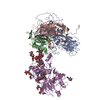
|
|---|---|
| 1 | x 60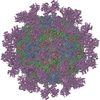
|
| 2 |
|
| 3 | x 5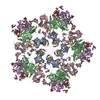
|
| 4 | x 6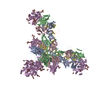
|
| 5 | 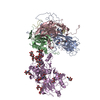
|
| Symmetry | Point symmetry: (Schoenflies symbol: I (icosahedral)) |
- Components
Components
-Protein , 5 types, 5 molecules ABCDE
| #1: Protein | Mass: 32755.766 Da / Num. of mol.: 1 / Source method: isolated from a natural source / Source: (natural)   Enterovirus A71 / References: UniProt: Q66479*PLUS Enterovirus A71 / References: UniProt: Q66479*PLUS |
|---|---|
| #2: Protein | Mass: 27784.213 Da / Num. of mol.: 1 / Source method: isolated from a natural source / Source: (natural)   Enterovirus A71 / References: UniProt: D4QGA2, UniProt: Q66479*PLUS Enterovirus A71 / References: UniProt: D4QGA2, UniProt: Q66479*PLUS |
| #3: Protein | Mass: 26540.332 Da / Num. of mol.: 1 / Source method: isolated from a natural source / Source: (natural)   Enterovirus A71 / References: UniProt: D4QGA3, UniProt: Q66479*PLUS Enterovirus A71 / References: UniProt: D4QGA3, UniProt: Q66479*PLUS |
| #4: Protein | Mass: 6380.943 Da / Num. of mol.: 1 / Source method: isolated from a natural source / Source: (natural)   Enterovirus A71 / References: UniProt: Q6YLE3, UniProt: Q66479*PLUS Enterovirus A71 / References: UniProt: Q6YLE3, UniProt: Q66479*PLUS |
| #5: Protein | Mass: 47727.750 Da / Num. of mol.: 1 Source method: isolated from a genetically manipulated source Source: (gene. exp.)  Homo sapiens (human) / Gene: SCARB2, CD36L2, LIMP2, LIMPII / Cell line (production host): HEK293T / Production host: Homo sapiens (human) / Gene: SCARB2, CD36L2, LIMP2, LIMPII / Cell line (production host): HEK293T / Production host:  Homo sapiens (human) / References: UniProt: Q14108 Homo sapiens (human) / References: UniProt: Q14108 |
-Sugars , 6 types, 8 molecules 
| #6: Polysaccharide | alpha-D-mannopyranose-(1-3)-beta-D-mannopyranose-(1-4)-2-acetamido-2-deoxy-beta-D-glucopyranose-(1- ...alpha-D-mannopyranose-(1-3)-beta-D-mannopyranose-(1-4)-2-acetamido-2-deoxy-beta-D-glucopyranose-(1-4)-2-acetamido-2-deoxy-beta-D-glucopyranose Source method: isolated from a genetically manipulated source | ||||||||
|---|---|---|---|---|---|---|---|---|---|
| #7: Polysaccharide | Source method: isolated from a genetically manipulated source #8: Polysaccharide | beta-D-mannopyranose-(1-4)-2-acetamido-2-deoxy-beta-D-glucopyranose-(1-4)-2-acetamido-2-deoxy-beta- ...beta-D-mannopyranose-(1-4)-2-acetamido-2-deoxy-beta-D-glucopyranose-(1-4)-2-acetamido-2-deoxy-beta-D-glucopyranose | Source method: isolated from a genetically manipulated source #9: Polysaccharide | alpha-D-mannopyranose-(1-2)-alpha-D-mannopyranose-(1-2)-alpha-D-mannopyranose-(1-3)-[alpha-D- ...alpha-D-mannopyranose-(1-2)-alpha-D-mannopyranose-(1-2)-alpha-D-mannopyranose-(1-3)-[alpha-D-mannopyranose-(1-2)-alpha-D-mannopyranose-(1-3)-[alpha-D-mannopyranose-(1-2)-alpha-D-mannopyranose-(1-6)]alpha-D-mannopyranose-(1-6)]beta-D-mannopyranose-(1-4)-2-acetamido-2-deoxy-beta-D-glucopyranose-(1-4)-2-acetamido-2-deoxy-beta-D-glucopyranose | Source method: isolated from a genetically manipulated source #10: Polysaccharide | alpha-D-mannopyranose-(1-3)-[alpha-D-mannopyranose-(1-6)]beta-D-mannopyranose-(1-4)-2-acetamido-2- ...alpha-D-mannopyranose-(1-3)-[alpha-D-mannopyranose-(1-6)]beta-D-mannopyranose-(1-4)-2-acetamido-2-deoxy-beta-D-glucopyranose-(1-4)-2-acetamido-2-deoxy-beta-D-glucopyranose | Source method: isolated from a genetically manipulated source #12: Sugar | |
-Non-polymers , 1 types, 1 molecules 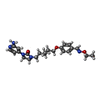
| #11: Chemical | ChemComp-906 / |
|---|
-Details
| Has protein modification | Y |
|---|
-Experimental details
-Experiment
| Experiment | Method: ELECTRON MICROSCOPY |
|---|---|
| EM experiment | Aggregation state: PARTICLE / 3D reconstruction method: single particle reconstruction |
- Sample preparation
Sample preparation
| Component |
| ||||||||||||||||||||||||
|---|---|---|---|---|---|---|---|---|---|---|---|---|---|---|---|---|---|---|---|---|---|---|---|---|---|
| Source (natural) |
| ||||||||||||||||||||||||
| Source (recombinant) | Organism:  Homo sapiens (human) / Cell: HEK293 Homo sapiens (human) / Cell: HEK293 | ||||||||||||||||||||||||
| Details of virus | Empty: YES / Enveloped: NO / Isolate: OTHER / Type: VIRION | ||||||||||||||||||||||||
| Natural host | Organism: Homo sapiens | ||||||||||||||||||||||||
| Buffer solution | pH: 5.1 | ||||||||||||||||||||||||
| Specimen | Conc.: 0.6 mg/ml / Embedding applied: NO / Shadowing applied: NO / Staining applied: NO / Vitrification applied: YES / Details: virus particle/SCARB2 ratio: 1:100 | ||||||||||||||||||||||||
| Vitrification | Cryogen name: ETHANE |
- Electron microscopy imaging
Electron microscopy imaging
| Experimental equipment |  Model: Tecnai Polara / Image courtesy: FEI Company |
|---|---|
| Microscopy | Model: FEI POLARA 300 |
| Electron gun | Electron source:  FIELD EMISSION GUN / Accelerating voltage: 300 kV / Illumination mode: FLOOD BEAM FIELD EMISSION GUN / Accelerating voltage: 300 kV / Illumination mode: FLOOD BEAM |
| Electron lens | Mode: BRIGHT FIELD |
| Image recording | Electron dose: 35 e/Å2 / Detector mode: SUPER-RESOLUTION / Film or detector model: GATAN K2 SUMMIT (4k x 4k) / Num. of real images: 757 |
- Processing
Processing
| Software | Name: PHENIX / Version: 1.13_2998: / Classification: refinement | ||||||||||||||||||||||||||||
|---|---|---|---|---|---|---|---|---|---|---|---|---|---|---|---|---|---|---|---|---|---|---|---|---|---|---|---|---|---|
| EM software |
| ||||||||||||||||||||||||||||
| CTF correction | Type: PHASE FLIPPING ONLY | ||||||||||||||||||||||||||||
| Symmetry | Point symmetry: I (icosahedral) | ||||||||||||||||||||||||||||
| 3D reconstruction | Resolution: 3.4 Å / Resolution method: FSC 0.143 CUT-OFF / Num. of particles: 10443 / Num. of class averages: 4 / Symmetry type: POINT | ||||||||||||||||||||||||||||
| Atomic model building | B value: 150 / Protocol: RIGID BODY FIT / Space: REAL | ||||||||||||||||||||||||||||
| Atomic model building |
|
 Movie
Movie Controller
Controller



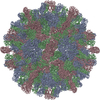
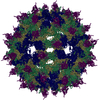


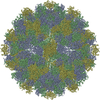
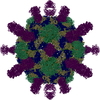
 PDBj
PDBj



